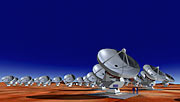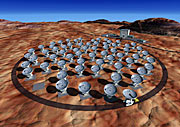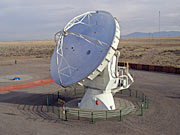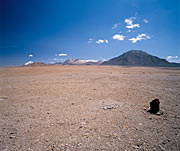Pressemeddelelse
ESO and NSF Sign Agreement on ALMA
Green Light for World's Most Powerful Radio Observatory
25. februar 2003
On February 25, 2003, the European Southern Observatory (ESO) and the US National Science Foundation (NSF) are signing a historic agreement to construct and operate the world's largest and most powerful radio telescope, operating at millimeter and sub-millimeter wavelength [1]. The Director General of ESO, Dr. Catherine Cesarsky, and the Director of the NSF, Dr. Rita Colwell, act for their respective organizations. Known as the Atacama Large Millimeter Array (ALMA), the future facility will encompass sixty-four interconnected 12-meter antennae at a unique, high-altitude site at Chajnantor in the Atacama region of northern Chile. ALMA is a joint project between Europe and North America. In Europe, ESO is leading on behalf of its ten member countries and Spain. In North America, the NSF also acts for the National Research Council of Canada and executes the project through the National Radio Astronomy Observatory (NRAO) operated by Associated Universities, Inc. (AUI). The conclusion of the ESO-NSF Agreement now gives the final green light for the ALMA project. The total cost of approximately 650 million Euro (or US Dollars) is shared equally between the two partners.
Dr. Cesarsky is excited: "This agreement signifies the start of a great project of contemporary astronomy and astrophysics. Representing Europe, and in collaboration with many laboratories and institutes on this continent, we together look forward towards wonderful research projects. With ALMA we may learn how the earliest galaxies in the Universe really looked like, to mention but one of the many eagerly awaited opportunities with this marvellous facility".
"With this agreement, we usher in a new age of research in astronomy" says Dr. Colwell. "By working together in this truly global partnership, the international astronomy community will be able to ensure the research capabilities needed to meet the long-term demands of our scientific enterprise, and that we will be able to study and understand our universe in ways that have previously been beyond our vision".
The recent Presidential decree from Chile for AUI and the agreement signed in late 2002 between ESO and the Government of the Republic of Chile recognize the interest that the ALMA Project has for Chile, as it will deepen and strengthen the cooperation in scientific and technological matters between the parties.
A joint ALMA Board has been established which oversees the realisation of the ALMA project via the management structure. This Board meets for the first time on February 24-25, 2003, at NSF in Washington and will witness this historic event.
ALMA: Imaging the Light from Cosmic Dawn
The Atacama Large Millimeter Array (ALMA) will be one of astronomy's most powerful telescopes - providing unprecedented imaging capabilities and sensitivity in the corresponding wavelength range, many orders of magnitude greater than anything of its kind today.
ALMA will be an array of 64 antennae that will work together as one telescope to study millimeter and sub-millimeter wavelength radiation from space. This radiation crosses the critical boundary between infrared and microwave radiation and holds the key to understanding such processes as planet and star formation, the formation of early galaxies and galaxy clusters, and the formation of organic and other molecules in space.
"ALMA will be one of astronomy's premier tools for studying the universe" says Nobel Laureate Riccardo Giacconi, President of AUI (and former ESO Director General (1993-1999)). "The entire astronomical community is anxious to have the unprecedented power and resolution that ALMA will provide".
The President of the ESO Council, Professor Piet van der Kruit, agrees: "ALMA heralds a break-through in sub-millimeter and millimeter astronomy, allowing some of the most penetrating studies the Universe ever made. It is safe to predict that there will be exciting scientific surprises when ALMA enters into operation".
What is millimeter and sub-millimeter wavelength astronomy?
Astronomers learn about objects in space by studying the energy emitted by those objects. Our Sun and the other stars throughout the Universe emit visible light. But these objects also emit other kinds of light waves, such as X-rays, infrared radiation, and radio waves. Some objects emit very little or no visible light, yet are strong sources at other wavelengths in the electromagnetic spectrum.
Much of the energy in the Universe is present in the sub-millimeter and millimeter portion of the spectrum. This energy comes from the cold dust mixed with gas in interstellar space. It also comes from distant galaxies that formed many billions of years ago at the edges of the known universe.
With ALMA, astronomers will have a uniquely powerful facility with access to this remarkable portion of the spectrum and hence, new and wonderful opportunities to learn more about those objects.
Current observatories simply do not have anywhere near the necessary sensitivity and resolution to unlock the secrets that abundant sub-millimeter and millimeter wavelength radiation can reveal. It will take the unparalleled power of ALMA to fully study the cosmic emission at this wavelength and better understand the nature of the universe.
Scientists from all over the world will use ALMA. They will compete for observing time by submitting proposals, which will be judged by a group of their peers on the basis of scientific merit.
ALMA's unique capabilities
ALMA's ability to detect remarkably faint sub-millimeter and millimeter wavelength emission and to create high-resolution images of the source of that emission gives it capabilities not found in any other astronomical instruments. ALMA will therefore be able to study phenomena previously out of reach to astronomers and astrophysicists, such as:
- Very young galaxies forming stars at the earliest times in cosmic history;
- New planets forming around young stars in our galaxy, the Milky Way;
- The birth of new stars in spinning clouds of gas and dust; and
- Interstellar clouds of gas and dust that are the nurseries of complex molecules and even organic chemicals that form the building blocks of life.
How will ALMA work?
All of ALMA's 64 antennae will work in concert, taking quick "snapshots" or long-term exposures of astronomical objects. Cosmic radiation from these objects will be reflected from the surface of each antenna and focussed onto highly sensitive receivers cooled to just a few degrees above absolute zero in order to suppress undesired "noise" from the surroundings. There the signals will be amplified many times, digitized, and then sent along underground fiber-optic cables to a large signal processor in the central control building.
This specialized computer, called a correlator - running at 16,000 million-million operations per second - will combine all of the data from the 64 antennae to make images of remarkable quality.
The extraordinary ALMA site
Since atmospheric water vapor absorbs millimeter and (especially) sub-millimeter waves, ALMA must be constructed at a very high altitude in a very dry region of the earth.
Extensive tests showed that the sky above the Atacama Desert of Chile has the excellent clarity and stability essential for ALMA. That is why ALMA will be built there, on Llano de Chajnantor at an altitude of 5,000 metres in the Chilean Andes.
A series of views of this site, also in high-resolution suitable for reproduction, is available at the Chajnantor Photo Gallery.
Timeline for ALMA
June 1998: Phase 1 (Research and Development);
June 1999: European/American Memorandum of Understanding;
February 2003: Signature of the bilateral Agreement;
2004: Tests of the Prototype System;
2007: Initial scientific operation of a partially completed array;
2011: End of construction of the array .
Noter
[1] This is a joint press release by ESO and the NSF.
Links
- European Southern Observatory (ESO)
- US National Science Foundation (NSF)
- Atacama Large Millimeter Array (ALMA)
- National Radio Astronomy Observatory (NRAO)
- Associated Universities, Inc. (AUI)
Kontakter
Richard West
ESO EPR Dept
Garching, Germany
Tel: +49-89-3200-6276
E-mail: rwest@eso.org
Charles E. Blue
National Radio Observatory
Charlottesville, VA, USA
Tel: +1-434-296-0323
E-mail: cblue@nrao.edu
Om pressemeddelelsen
| Pressemeddelelse nr.: | eso0306 |
| Legacy ID: | PR 04/03 |
| Navn: | Atacama Large Millimeter/submillimeter Array |
| Type: | Unspecified : Technology : Observatory : Telescope |
| Facility: | Atacama Large Millimeter/submillimeter Array |
Our use of Cookies
We use cookies that are essential for accessing our websites and using our services. We also use cookies to analyse, measure and improve our websites’ performance, to enable content sharing via social media and to display media content hosted on third-party platforms.
ESO Cookies Policy
The European Organisation for Astronomical Research in the Southern Hemisphere (ESO) is the pre-eminent intergovernmental science and technology organisation in astronomy. It carries out an ambitious programme focused on the design, construction and operation of powerful ground-based observing facilities for astronomy.
This Cookies Policy is intended to provide clarity by outlining the cookies used on the ESO public websites, their functions, the options you have for controlling them, and the ways you can contact us for additional details.
What are cookies?
Cookies are small pieces of data stored on your device by websites you visit. They serve various purposes, such as remembering login credentials and preferences and enhance your browsing experience.
Categories of cookies we use
Essential cookies (always active): These cookies are strictly necessary for the proper functioning of our website. Without these cookies, the website cannot operate correctly, and certain services, such as logging in or accessing secure areas, may not be available; because they are essential for the website’s operation, they cannot be disabled.
Functional Cookies: These cookies enhance your browsing experience by enabling additional features and personalization, such as remembering your preferences and settings. While not strictly necessary for the website to function, they improve usability and convenience; these cookies are only placed if you provide your consent.
Analytics cookies: These cookies collect information about how visitors interact with our website, such as which pages are visited most often and how users navigate the site. This data helps us improve website performance, optimize content, and enhance the user experience; these cookies are only placed if you provide your consent. We use the following analytics cookies.
Matomo Cookies:
This website uses Matomo (formerly Piwik), an open source software which enables the statistical analysis of website visits. Matomo uses cookies (text files) which are saved on your computer and which allow us to analyze how you use our website. The website user information generated by the cookies will only be saved on the servers of our IT Department. We use this information to analyze www.eso.org visits and to prepare reports on website activities. These data will not be disclosed to third parties.
On behalf of ESO, Matomo will use this information for the purpose of evaluating your use of the website, compiling reports on website activity and providing other services relating to website activity and internet usage.
Matomo cookies settings:
Additional Third-party cookies on ESO websites: some of our pages display content from external providers, e.g. YouTube.
Such third-party services are outside of ESO control and may, at any time, change their terms of service, use of cookies, etc.
YouTube: Some videos on the ESO website are embedded from ESO’s official YouTube channel. We have enabled YouTube’s privacy-enhanced mode, meaning that no cookies are set unless the user actively clicks on the video to play it. Additionally, in this mode, YouTube does not store any personally identifiable cookie data for embedded video playbacks. For more details, please refer to YouTube’s embedding videos information page.
Cookies can also be classified based on the following elements.
Regarding the domain, there are:
- First-party cookies, set by the website you are currently visiting. They are stored by the same domain that you are browsing and are used to enhance your experience on that site;
- Third-party cookies, set by a domain other than the one you are currently visiting.
As for their duration, cookies can be:
- Browser-session cookies, which are deleted when the user closes the browser;
- Stored cookies, which stay on the user's device for a predetermined period of time.
How to manage cookies
Cookie settings: You can modify your cookie choices for the ESO webpages at any time by clicking on the link Cookie settings at the bottom of any page.
In your browser: If you wish to delete cookies or instruct your browser to delete or block cookies by default, please visit the help pages of your browser:
Please be aware that if you delete or decline cookies, certain functionalities of our website may be not be available and your browsing experience may be affected.
You can set most browsers to prevent any cookies being placed on your device, but you may then have to manually adjust some preferences every time you visit a site/page. And some services and functionalities may not work properly at all (e.g. profile logging-in, shop check out).
Updates to the ESO Cookies Policy
The ESO Cookies Policy may be subject to future updates, which will be made available on this page.
Additional information
For any queries related to cookies, please contact: pdprATesoDOTorg.
As ESO public webpages are managed by our Department of Communication, your questions will be dealt with the support of the said Department.




